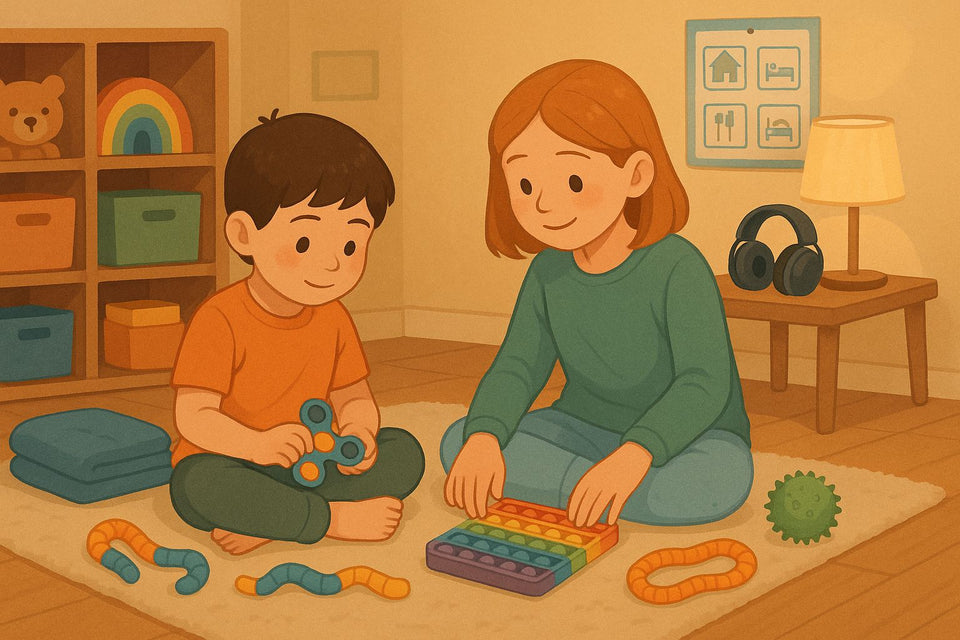Same Age, Different Worlds: Raising Siblings With and Without Autism
Life with kids is always an adventure – a sticky, noisy, heart-bursting, sleep-deprived adventure. But when you're raising siblings close in age and one is on the autism spectrum while the other is not, it’s like parenting in stereo – but one speaker’s playing Mozart and the other’s blasting The Wiggles at double speed.
So, what’s the difference? And how do we juggle the very real needs of both kids without feeling like we need to clone ourselves (or drink our coffee while it’s hot for once)?
Understanding the Differences
Raising a child with Autism Spectrum Disorder (ASD) can look vastly different from raising a neurotypical child. You might notice:
-
Communication styles differ: One child might be verbal and socially eager, while the other communicates through gestures, scripting, or prefers solo play.
-
Sensory needs clash: While your neurotypical child might be obsessed with slime, your child with ASD might recoil at the texture.
-
Routine vs spontaneity: One thrives on predictability and repetition, while the other wants new experiences and constant change.
When They're Close in Age… Oh Boy.
Children close in age are often expected to hit similar milestones together – starting school, riding bikes, attending parties. But in neurodiverse households, those milestones come at different times (if at all), and that’s OK.
The tricky bit? Explaining to the neurotypical sibling why their brother or sister doesn’t talk like them, needs more of Mum and Dad’s time, or gets extra support in school.
Tips for Managing the Dynamic
1. Celebrate individual wins:
Acknowledge each child’s strengths and successes – whether it's tying a shoelace or making eye contact for the first time.
2. Educate with compassion:
Teach your neurotypical child about autism in a positive, age-appropriate way. Books, videos, or even comparing their sibling’s brain to a superhero power can help.
3. Balance attention:
It’s easy for your child with ASD to get the lion’s share of your time (because therapies, meltdowns, and routines don’t schedule themselves). But one-on-one time with your neurotypical child is just as important, even if it’s just 10 minutes of Lego and undivided attention.
4. Encourage bonding:
Find shared interests (even if it's just spinning in circles or jumping on a trampoline) to build a sibling connection.
5. Plan for flexibility:
Structure helps everyone, but be prepared for plans to change – and don’t beat yourself up when they do.
Looking Ahead: The Expectations Shift
As kids grow, the gap in development between a child on the spectrum and their sibling may widen – or it may narrow. Either way, your parenting lens shifts from “immediate needs” to “lifelong support.”
-
For your child with ASD:
There may be extra considerations for schooling, independence, social development, and even employment. They may always need more guidance – and that’s OK. -
For your neurotypical child:
You may notice a growing sense of responsibility, confusion, or even resentment. Let them express these feelings. Normalize them. It’s not about equal treatment – it’s about fair and compassionate treatment. -
For you as a parent:
Expect your parenting toolbox to expand. Expect to be an advocate, a therapist, a referee, a safe place, and a cheerleader (sometimes all before 10 a.m.).
And remember: you are not doing it wrong just because it’s hard. You’re raising children with different operating systems, and it takes patience, humour, and support.
In the End…
Your home may never be quiet, your routines may never be predictable, and your coffee may never be hot – but you’re building a family full of empathy, resilience, and fierce love.
Siblings in a neurodiverse home may argue over toys like all kids do, but they’ll also learn the art of acceptance, flexibility, and the beauty of difference. And that’s a gift for life.
Need Support for Both Kiddos?
At Sensory Planet, we’ve curated tools for every sensory need – from calming toys to social development aids. Check out our Sibling Support Collection for items designed to help your whole family thrive.
Have a story to share or a tip that works for your crew? Drop a comment below – you never know who you might help by sharing it






